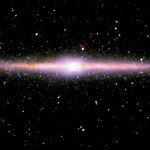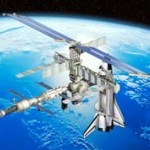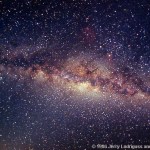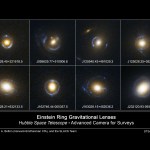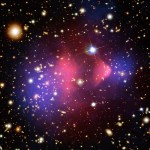Astronomy
When I think of molecules, I think of Conan O'Brien doing his skit where he plays Moleculo...
the molecular man! I don't think of astronomy, and I certainly don't think of the leftover radiation from the big bang (known as the cosmic microwave background)! But somebody over at the European Southern Observatory put these two together and made an incredibly tasty science sandwich.
See, we can measure the cosmic microwave background today, because we have photons (particles of light) coming at us in all directions at all locations, with a temperature of 2.725 Kelvin. Theoretical cosmology…
Since the dawn of time man has yearned to destroy the sun. - C. M. Burns
There's no need to stop at the Sun, though. Since yesterday was Earth day, I thought it was only appropriate to spend today telling you how not only to destroy the Earth, but to effectively destroy the entire Universe. To tell you this story, we have to go all the way back to the beginning, to just before the big bang.
The big bang was when the Universe was hot, dense, full of energy, and expanding very quickly. The Universe was also spatially flat and the same temperature everywhere, and full of both matter and…
A favorite quote of mine from Vincent van Gogh: "For my part I know nothing with any certainty, but the sight of the stars makes me dream." Especially when I can access them through my web browser. Here in Seattle this is greatly needed, since there are vast portions of the winter when the night sky is hidden behind puffy clouds. I mean I need to be reminded every once in a while that I'm a little little speck in a big big universe.
First one to spot a Dyson sphere wins.
tags: mars, Martian Sand Dunes, NASA, astronomy, Image of the Day
Cool Shot of Thawing Sand Dunes Near Martian Polar Region.
Image: NASA. [larger size].
Alright, startswithabang-ers, Ben, my most avid commenter, saw me online while I was eating breakfast this morning, and pointed me to this new press release. Now, before you get started clicking on everything, the guy who the release is about is Brian Gaensler, who's a really nice guy, lives in Australia, whom I met at the AAS (American Astronomical Society) meeting in Austin, TX last month. Bryan's also brilliant.
Basically, what he did was he said, "well, we know what the rough density of hot gas in our galaxy is, and we can measure the timing of these pulsars to extraordinary accuracy."…
Ever get sick of your life here on Earth? What about really getting away from it all; what if you wanted to live in space, orbiting the Earth, away from everyone. (At least for awhile, like a summer home.) What would you need to do it, and what would it consist of?
I propose an idea which I'll call a "space house," where I'll go through what I think is the cheapest and easiest way to get all the things you would need to comfortably survive in space for an extended period of time. First off, let's go over all the things a human would need to survive, while still having a good life, in space…
Okay, so I got a question from my friend Tamara, who's a high school teacher in my hometown of New York City. It concerns a recent article she read on the front page of the New York Times about something funny that us scientists are calling Boltzmann Brains.
I've read this article three times since it was featured on the front page of the science section in the NYT and I'm still confused about the Boltzmann brain problem, it's (non?)validity, the reason it made it's way onto the front page and whether Emerson's philosophy about imagined worlds came from this...
There's a lot of interesting…
I got a great question earlier today from my buddy Zrinka, and decided to figure out the answer for her, and also for myself. She asks:
Ethan, is it possible to know, or better to say to imagine somehow how our galaxy looks from outside?
What a simple-sounding question! After all, we know what the Earth looks like from the outside: we just go outside of it and photograph it. But the galaxy is too big to do that to; it would take tens of thousands of years moving at the speed of light to get that far away! So we're left with the option of looking at our galaxy from inside of it, and trying to…
One of the perks of being a postdoc at a place like the University of Arizona, one of the top places in the US for astronomy, is that we get a number of really interesting visitors. Today we got paid a visit by Tommaso Treu, an astronomer at UC Santa Barbara.
He spoke to us today about one of his most recent, most interesting discoveries, done with the Hubble Space Telescope, of a double Einstein Ring. Take a look at the image below:
You'll notice that there's a ball of light in the center with some ring-like structure(s) around it. These things are rare, first off. There are only two ways…
Dave, one of my online chessplaying buddies, asked me this question (edited for appropriateness):
Now this speeding up of the expansion of the universe: Do I understand correctly that one of the theories to explain why relates to "dark matter"?
In real simple terms, what in the dark blue blazes is dark matter, and why and how (and I think the "how" is what keeps you boys up late at night) does it cause this increase in speed?
So Dave gives me the opportunity to, first off, make the distinction between dark matter and dark energy.
Dark matter is, quite simply, matter that doesn't emit…
Taking a look at the background picture, and wondering what it is? It's the Bullet Cluster, also known to astronomers as 1E 0657-56.
What's so special about it? Well, these are actually two galaxy clusters that are in the process of merging, and are colliding with one another! Although this is very cool (and rare) in and of itself, finding this object allowed us to test experimentally the dark matter hypothesis.
If all of the matter in the universe was composed of protons, neutrons, and electrons, then we would find mass in the same place we find light. But look at the x-ray…
tags: Comet McNaught, Great Comet of 2007, Astronomy, NewScientist, Image of the Day
Comet McNaught.
Also known as the Great Comet of 2007, McNaught is the brightest comet for over 40 years and the second brightest since 1935.
Image: Noeleen Lowndes 2007 (NewScientist calendar 2008). [Much larger view]
The fourth edition of the new Natural Sciences Blog Carnival is now available for you to read and enjoy. They saw fit to include a few pieces that I wrote -- considering that I have felt very discouraged and depressed this past month (terminal unemployment combined with lots of job rejections can do that to a person after a few years -- try it sometime if you don't believe me), it is a great compliment to see that someone out there considers my writing to be worthwhile, at least.
tags: researchblogging.org, Tunguska event, Siberian explosion, Podkamennaya Tunguska River, Lake Cheko, planet earth, astronomy
Flattened trees cover vast areas of Northeastern Siberia
after the mysterious Tunguska explosion in June, 1908.
Image: TASS/Sovfoto (public domain?) [larger view].
As a kid, I was fascinated by the mysterious explosion that occurred over Siberia. Basically, in the morning of 30 June 1908, a few native peoples in Siberia reported seeing a blue light in the sky that was as bright as the sun and hearing a series of loud explosions, accompanied by fierce winds and…
tags: comet holmes, night sky, astronomy
Comet Holmes rises in the northeastern sky above Coyote Canyon in Anza Borrego Desert State Park, California. It's visible to the naked eye and better seen with binoculars. Discovered in the late 19th Century, Holmes has become dramatically brighter in the past 2 weeks.
Image: Don Bartletti (Los Angeles Times).
I just learned about the amazing Comet Homes, which has unexpectedly brightened more than one million times literally overnight, its appearance changing from that of a normal comet with a tail into a brilliant, tailless puffball in the night…
A team of astronomers from Cambridge and Caltech recently used a ground-based camera called "Lucky" to take stellar pictures that are much sharper than those taken by the beloved Hubble telescope—and cost 50,000 times less.
The photos above show the famous Cat's Eye Nebula (NGC 6543), 3,000 light-years away from us, as taken by a standard 200-inch telescope (left) and with the Lucky Camera attached to the same telescope (right). The Lucky camera can zoom in on the kots, jets and arcs that make up the Nebula's core.
Ground-based telescopes are usually less than ideal for space photos…
After Google Mars, perhaps this was inevitable: Google Moon celebrates the anniversary of the first manned moon landing by presenting a swath of the lunar surface, mapped in the familiar Google style, with red flags marking the locations of six Apollo landing sites.
The project, explains Google Moon's about page, is part of Google's Copernicus initiative:
We can confirm that on July 20th, 2069, in honor of the 100th anniversary of mankind's first manned lunar landing, Google will fully integrate Google Local search capabilities into Google Moon, which will allow our users to quickly find…
The volume is slim, just seventeen pages long--an elegant, tall rectangle of cream-colored paper. Looking at the scanned pages, it seems almost possible to reach out and touch the yellowed crease of the cover, the rusted staples.
"INTRODUCTION TO OUTER SPACE," the booklet reads. "THE WHITE HOUSE; March 26, 1958."
What follows is a primer on space science and space exploration, written by Dwight Eisenhower's Science Advisory Committee, prepared to explain to "the nontechnical reader" the aims of and reasons for the United States space program.
Space Law Probe has a link to the whole document…
Mapping the universe wouldn't be possible without technological marvels like the Hubble Telescope. But a new census of one million galaxies also requires the talents of the human eye.
Last week, astronomers from the University of Oxford, the University of Portsmouth and Johns Hopkins University launched the Galaxy Zoo project, a website that showcases stunning images of galaxies and asks visitors to help classify them.
Why do they need you, you ask? Well, the human brain is better at recognizing patterns than a computer. "Any computer program we write to sort our galaxies," the website…
This week, in the Mexican oil city of Tampico, an orb-like, robotic submarine begins its 1,000-foot plunge to the bottom of an underwater cavern, the largest sinkhole in the world. As part of the NASA-sponsored DEPTHX project, the autonomous robot, endearingly called "Clementine," will probe exotic rocks and microbes that may be the key to finding life on Europa, Jupiter's largest moon.
Last Saturday, ranch hands of Rancho la Azufrosa helped get Clementine out of storage.
According to NASA's current plans, it'll be at least 30 years before robots get to airless, ice-crusted Europa. Despite…


